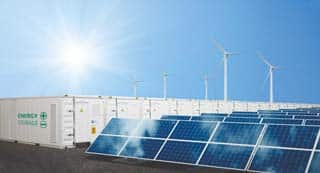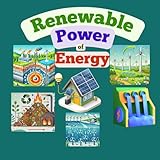
Battery Energy Storage
What is a Battery Energy Storage System
![]() A Battery Energy Storage System or BESS for short is a technology and concept designed to store electrical energy within deep cycle batteries for use later when needed.
A Battery Energy Storage System or BESS for short is a technology and concept designed to store electrical energy within deep cycle batteries for use later when needed.
It allows electricity generated during periods of low demand or high renewable generation (like solar and wind power) to be stored and released when it’s needed. BESS also helps in stabilising the mains utility grid, manage peak load demands, improve overall energy efficiency being distributed, as well as support renewable energy integration into the grid.
The amount of electricity produced by a renewable energy system will always vary throughout the day depending upon weather conditions. For example, it could be zero production when the sun does not shine or the wind does not blow.
Generally, homes, offices shops and buildings need an electric supply at all times whether it is being produced by renewables or not. In these cases, deep cycle storage batteries can be used to store excess electricity and make it available at a later time.

Deep cycle batteries have already proven to be a viable energy storage technology. Battery Energy Storage Systems can benefit all sectors of modern life from home solar systems to electric vehicle transportation, to mains utility companies in their generation, transmission, and storage of mains electric power around the countryside.
The term “battery” defines a device comprising of two electrodes and an electrolyte positioned together within a sealed container allowing for the connection of an external load. The two electrodes, one called the Anode (+) and the other called the Cathode (-), respectively, are positioned on each side of an electrolyte allowing electrons to flow through it to an external circuit. Thus to maintain an electric current in the external circuit, electrons leave the anode and return to the cathode.
Energy storage devices have come a long way from the old lead–acid (PbA) battery within an uninterruptible power supply (UPS), used to keep the lights on. Today as technology advances and changes rapidly, the development in batteries performance is constantly progressing towards storage batteries with a much higher energy density and longer their life span, as well as be environmentally harmless and recyclable. Next generation battery technologies such as lithium-ion, zinc–air, lithium–sulphur, lithium–air, etc. improve on the energy capacities of rechargeable lithium batteries.
While energy storage is not part of an electrical generating system as such, it can still be used with power generating and renewable technologies to provide backup power for intermittent and/or peak power needs. Generation of electricity from renewable resources such as the sun, wind, water, and biomass can provide usable power. But unless this clean energy can be safely stored in a cost-effective way, it could become lost.
Then large-scale energy storage systems in the form of electrochemical batteries based on the electricity generated from renewable sources offers enormous potential for meeting our future energy demands.
How Does a Battery Energy Storage System Work
Storage batteries have proven to be a very popular energy storage medium, based primarily on their convenience, low cost and lack of moving parts (low maintenance). Electrochemical secondary batteries are usually defined by their efficiency, depth of discharge, number of charging cycles, energy density and self-discharge, as well as their terminal voltage, which varies according to the electric current drawn and their state of charge.
Battery storage devices can be classified by the following three categories:
1. Input Energy (Charging)
During periods of excess energy generation, such as when renewable sources like solar or wind produce more energy than needed, the BESS absorbs and stores the surplus electricity. The energy can also come from the grid during times of low demand, when electricity is cheaper.
Thus the storage system operates through the following steps:
- Electricity is generated by a power plant or renewable energy source.
- The BESS converts the electrical energy into chemical energy, storing it in the battery cells.
- Battery Management Systems monitor the charging process to ensure safety and efficiency, optimising the charge and preventing overcharging, overheating, or damage.
2. Energy Storage
Once the energy is stored, the electricity remains in the system in the form of chemical energy. The type of battery used in the system (e.g., lithium-ion, lead-acid, or flow batteries) determines how energy is stored and how much energy the system can hold.
- Lithium-ion batteries are the most common due to their high energy density, efficiency, and long lifespan.
- Flow batteries use liquid electrolytes and are more suitable for large-scale, long-duration storage.
- Lead-acid batteries are older technology but still used in certain applications because they are cost-effective and reliable.
- During the storage phase, the BMS continues to monitor the state of charge, ensuring that the energy is stored safely and remains ready for discharge when needed.
3. Energy Discharge (Power Output)
When there is a demand for power, or during peak consumption periods, the stored energy is discharged from the batteries and converted back into electrical energy.
- The stored chemical energy is converted back into electrical energy via an electrochemical reaction within the battery.
- The BESS releases electricity back into the grid or to a local load (such as a building, factory, or microgrid).
- The Inverter in the system converts the direct current (DC) from the battery to alternating current (AC), which is compatible with the power grid or consumer appliances.
- This process ensures a continuous supply of electricity even when generation is lower or demand is high.
Key Components of a Battery Energy Storage System
Battery Cells: – The core of the system where the energy is stored.
Sine Wave Inverter: – This converts the DC power stored in batteries to AC power, which can be used in and around the home by most electrical devices.
Battery Management System (BMS): – A critical component that monitors the health, performance, and safety of the batteries, optimising charge and discharge cycles.
Power Conversion System (PCS): – Includes the inverter and rectifier, which help convert between AC and DC power.
Energy Management System (EMS): – Software that controls and manages the overall operation of the BESS, including energy flow, monitoring, and optimisation.
Cooling System: – Prevents overheating by maintaining an optimal temperature for the battery cells.
The Types of Secondary Batteries Used in a BESS
1. Lithium-Ion (L-ion) Batteries: – The most common type of battery used in most battery energy storage systems and hand held devices due to their high energy density, efficiency, and fast response time.
- Pros: High efficiency, long cycle life, compact, safe.
- Cons: Higher cost, sensitivity to temperature, and risk of thermal runaway if over-charged.
2. Lead-Acid (PbA) Batteries: – An old secondary cell technology that is widely used in some storage systems, vehicles and other applications requiring high values of load current.
- Pros: Low-cost, reliable, maturity of technology, and efficient recycling.
- Cons: Short cycle life, lower energy density, weight.
3. Redox Flow (RF) Batteries: – These are a type of rechargeable fuel cell which stores and releases electrical energy by exploiting the reversible electrochemical reactions of two liquid electrolytes flowing into and out of a cell through separate loops. They are suitable for large-scale energy storage systems.
- Pros: Long life, scalable for large capacity, suitable for long-duration storage.
- Cons: Low energy density, and high cost for small applications.
4. Sodium Sulphur (NaS) Batteries: – Is a liquid-metal battery which uses sodium (Na) as a negative-electrode material and sulphur (S) as the positive electrode material. Due to its high operating temperatures it is used for large-scale, long-duration energy storage.
- Pros: High energy density, efficient for long-duration discharge.
- Cons: High operating temperatures, highly corrosive, aqueous electrolytes cannot be used.
Advantages of a Battery Energy Storage Systems
All energy sources are stored in one form or other, whether on a geological scale in nature in the form of fossil fuels, or on a much larger scale in the form of solar energy (the sun). These stores of energy are used up either in the form of mechanical power, or heat energy according to human need.
Battery energy storage systems are based on storing electricity generated from renewable sources such as sun and wind offering enormous potential for meeting our future energy needs. Chemical energy storage devices as well as electrochemical supercapacitors are now among the leading BESS technologies of today.
Energy storage has now become a major issue with the increase of renewable energy systems in the home and as part of electrical power generation. The ability to store large amounts of electrical energy using a deep cycle battery will allow utility companies to have greater flexibility in their operation over an increase in supply and demand. The advantages of battery energy storage systems can be listed as follows:
- Increased grid reliability by stabilising power supply and preventing blackouts.
- Renewable energy integration: Enables better use of intermittent renewable sources like wind and solar by storing excess power.
- Reduced energy costs: Consumers can store energy when prices are low and use it when prices rise.
- Reduced carbon footprint: Supports the shift to cleaner energy sources by optimizing renewable energy usage.
- Backup power: Provides emergency power in the event of a grid outage.
Tutorial Summary
In summary, a Battery Energy Storage System, or simply BESS is an essential tool for modernising and stabilising power grids, especially in the context of increasing renewable energy use and decentralising energy generation. An energy storage system stores excess electricity when it’s available and releases it during peak demand or shortages, improving grid reliability, efficiency, and flexibility.
While it is clear that there is a cost associated with storing energy, in many cases the storage of electrical energy in batteries can be cost effective. Furthermore, as time, technology and demand improves, more and more possible applications for battery energy storage systems will emerge as more research and development is this field is made.
To learn more about how battery energy storage systems allow the excess energy produced from renewables technologies, like solar and wind, to be stored and then released when needed, or to obtain more information about batteries. Then find the ideal battery energy storage system book today direct from Amazon and understand how you can use a BESS system to power your home.











Please Speak up!
We hope this Battery Energy Storage System Tutorial was useful and informative for you. Are you ready to share your thoughts
and experience with us and many others. Your comments are always welcome, just post them in the section below.
P.S. Don't forget to like, rate, and share this Alternative Energy Tutorials post. Thank you for using our website.